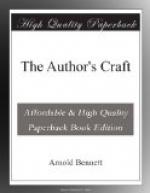PART IV
THE ARTIST AND THE
PUBLIC
I
I can divide all the imaginative writers I have ever met into two classes—those who admitted and sometimes proclaimed loudly that they desired popularity; and those who expressed a noble scorn or a gentle contempt for popularity. The latter, however, always failed to conceal their envy of popular authors, and this envy was a phenomenon whose truculent bitterness could not be surpassed even in political or religious life. And indeed, since (as I have held in a previous chapter) the object of the artist is to share his emotions with others, it would be strange if the normal artist spurned popularity in order to keep his emotions as much as possible to himself. An enormous amount of dishonest nonsense has been and will be written by uncreative critics, of course in the higher interests of creative authors, about popularity and the proper attitude of the artist thereto. But possibly the attitude of a first-class artist himself may prove a more valuable guide.
The Letters of George Meredith (of which the first volume is a magnificent unfolding of the character of a great man) are full of references to popularity, references overt and covert. Meredith could never—and quite naturally—get away from the idea of popularity. He was a student of the English public, and could occasionally be unjust to it. Writing to M. Andre Raffalovich (who had sent him a letter of appreciation) in November, 1881, he said: “I venture to judge by your name that you are at most but half English. I can consequently believe in the feeling you express for the work of an unpopular writer. Otherwise one would incline to be sceptical,




